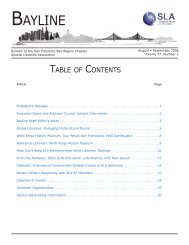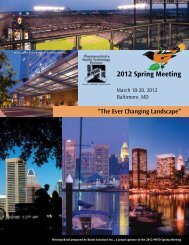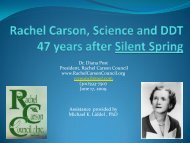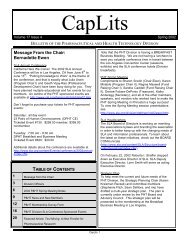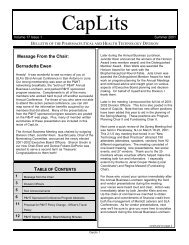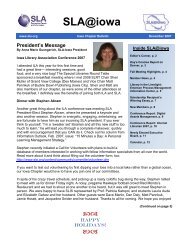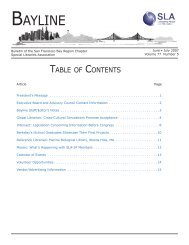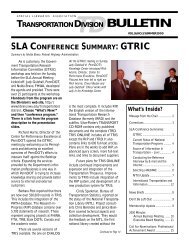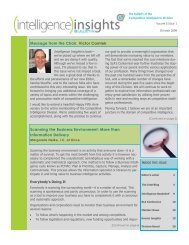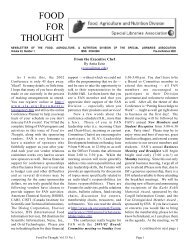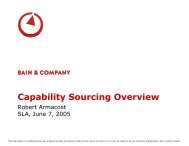Education Libraries - Special Libraries Association
Education Libraries - Special Libraries Association
Education Libraries - Special Libraries Association
Create successful ePaper yourself
Turn your PDF publications into a flip-book with our unique Google optimized e-Paper software.
program and the Teaching and Learning<br />
Center’s faculty development programs and<br />
will serve as a regional education resource. It<br />
will provide “collections,” services to students<br />
and faculty, and programs appropriate to<br />
identified goals.<br />
Key words and phrases from this description (such<br />
as “transform,” “K-20,” “teaching and learning,”<br />
and “effective use of technology”) and the<br />
emphasis on partnership clarified expectations.<br />
The new job title, “learning resources librarian,”<br />
indicated responsibilities beyond maintaining a<br />
collection. The search committee and library<br />
administrators who interviewed candidates<br />
reinforced these expectations during the interview<br />
process, and each finalist was asked to present her<br />
ideal model of the twenty-first century curriculum<br />
center to library staff.<br />
The responsibilities detailed<br />
in Meyer’s faculty activity<br />
plan and annual letter of<br />
assignment also differed<br />
from those of the other<br />
reference and instruction<br />
librarians. Time on the<br />
reference desk was greatly<br />
reduced (4% of her time),<br />
while liaison and outreach responsibilities were<br />
increased (18%). She also was assigned greater<br />
responsibility in collection development than most<br />
of the other EWU reference and instruction<br />
librarians. This shift in emphasis set the<br />
expectation to try new ideas, such as moving<br />
“beyond the reference desk” to meet library staff<br />
and others (Stoddart, Bryant, Baker, Lee, &<br />
Spencer, 2006). She discovered allies for<br />
particular types of change, and she learned longstanding<br />
concerns about the Curriculum Center.<br />
Learning about the history of the center helped to<br />
strengthen Meyer’s eventual proposals for change<br />
and moved them more quickly towards approval.<br />
Frequent communication with library leadership<br />
helped Meyer to refine and focus her ideas for<br />
transforming the center. In her first quarter at<br />
EWU, Meyer met weekly with Julie Miller, the<br />
associate dean and acting division head to whom<br />
Meyer reported, at a campus coffee shop. They<br />
To transform the Curriculum Center<br />
at EWU, organizational leadership<br />
has meant setting high expectations,<br />
removing barriers to communication,<br />
and encouraging flexibility across<br />
the organization.<br />
discussed and drafted the mission and vision<br />
statements during these meetings. Miller’s<br />
experience with strategic planning helped with the<br />
visioning process. They also had open<br />
conversation about education, the library, and<br />
future plans that prompted ideas. These<br />
discussions helped Meyer to define her role within<br />
EWU libraries; they also helped Miller to<br />
understand and explain changes in the Curriculum<br />
Center to others in the organization.<br />
Meyer also had frequent communication with<br />
Carolynne Myall, head of Collection Services and<br />
current faculty chair. Myall has a personal interest<br />
in children’s literature, and she has been the<br />
primary selector for children’s literature for the<br />
Curriculum Center for several years. Myall’s<br />
knowledge of the center’s collection and its<br />
history was invaluable to Meyer. Meyer<br />
understood that many of her proposals would<br />
require changes in policy,<br />
procedures, and workload.<br />
Through a shared<br />
commitment to service for<br />
students, Meyer and Myall<br />
worked through these thorny<br />
issues. Their open<br />
communication facilitated<br />
many of the rapid changes in<br />
the center’s materials collections. Within the first<br />
academic year, Collections Services staff provided<br />
support for weeding the Curriculum Center’s<br />
collection by one third, implemented a new<br />
process for retaining juvenile book covers, began a<br />
reclassification of all items, and consolidated and<br />
reorganized the physical space. It was a busy time!<br />
This level of change, particularly in an academic<br />
setting, requires flexibility, something which can<br />
be difficult in a standards-based environment such<br />
as a library. The guiding principles from the vision<br />
document helped library faculty and staff become<br />
more flexible during this time of change. The<br />
principles gave direction and focus. Meyer and<br />
Miller did not heedlessly throw out standards or<br />
make change for the sake of change. Rather, they<br />
made recommendations for change based on the<br />
guiding principles. The reclassification project<br />
implemented in 2007 demonstrates how the<br />
guiding principles facilitated flexibility.<br />
<strong>Education</strong> <strong>Libraries</strong>, Volume 31, No. 2, Winter 2008 25



